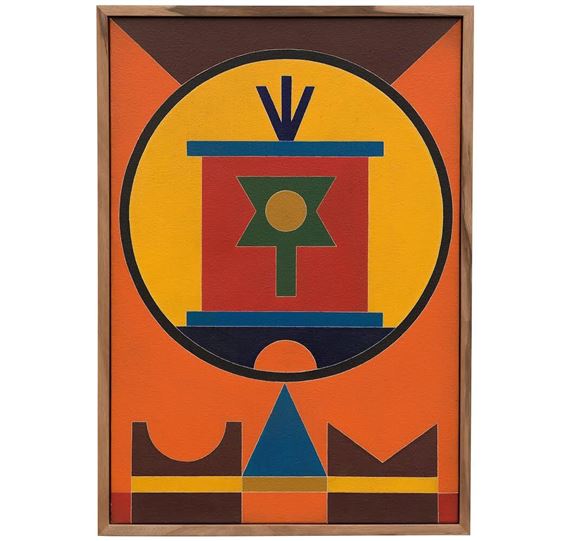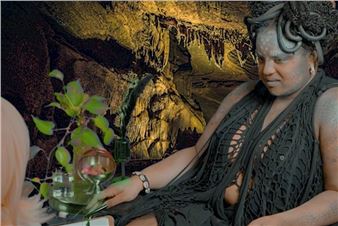Rubem Valentim
The approach is proud to present the first solo exhibition in the UK of one of the key figures of 20th-century Brazilian art and Afro-Atlantic histories: Rubem Valentim (1922 ÔÇô 1991) was among the first generation of artists who were openly inspired by the sacred symbology of Afro-Brazilian religions and adopted a syncretic approach within their respective practices. Along the likes of Agnaldo Manoel dos Santos, Caryb├® and Mestre Didi, who shared this common vision, Valentim was instrumental in introducing the wider Brazilian population to the visual vocabulary of these religions and the cultural significance of the Northeast Brazil. The show features the artistÔÇÖs signographic paintings and votive sculptures conceived during the years 1972 to 1990.
A self-taught artist, Valentim began to paint in 1946 during which time he also obtained a degree in dentistry. Eventually abandoning the latter profession, the artist quickly became an active figure and involved in BahiaÔÇÖs artistic and literary circles. Looking outward, during this time the artist also drew great inspiration from the works of Paul C├®zanne, Paul Klee, and Joan Mir├│. The following decade proved to be a significant period for Valentim as during this time he produced increasingly abstract works which fortuitously also marked the start of his itineration from his hometown Salvador to Rio de Janeiro. He later on settled in Rome and London, before moving to Bras├¡lia, the last of which was deemed a necessary and foundational step for artists of his generation.
Insofar as ValentimÔÇÖs manifesto possesses a regional, and even personal, character, his writings also appear to garner a more universal audience. The delay to which the artist refers to in the title of his manifesto, was perhaps an innuendo given its apt and timely probe into the artistic processes that had up until then been marginalised and rendered invisible. In a sense, the phrase ainda que tardio [albeit late] indicates the artistÔÇÖs awareness of a delay in lending credence to the Africa-descended population in the Brazilian societyÔÇöa noble and socially significant undertaking that is now as urgent as it ever was.

Recommended for you
The approach is proud to present the first solo exhibition in the UK of one of the key figures of 20th-century Brazilian art and Afro-Atlantic histories: Rubem Valentim (1922 ÔÇô 1991) was among the first generation of artists who were openly inspired by the sacred symbology of Afro-Brazilian religions and adopted a syncretic approach within their respective practices. Along the likes of Agnaldo Manoel dos Santos, Caryb├® and Mestre Didi, who shared this common vision, Valentim was instrumental in introducing the wider Brazilian population to the visual vocabulary of these religions and the cultural significance of the Northeast Brazil. The show features the artistÔÇÖs signographic paintings and votive sculptures conceived during the years 1972 to 1990.
A self-taught artist, Valentim began to paint in 1946 during which time he also obtained a degree in dentistry. Eventually abandoning the latter profession, the artist quickly became an active figure and involved in BahiaÔÇÖs artistic and literary circles. Looking outward, during this time the artist also drew great inspiration from the works of Paul C├®zanne, Paul Klee, and Joan Mir├│. The following decade proved to be a significant period for Valentim as during this time he produced increasingly abstract works which fortuitously also marked the start of his itineration from his hometown Salvador to Rio de Janeiro. He later on settled in Rome and London, before moving to Bras├¡lia, the last of which was deemed a necessary and foundational step for artists of his generation.
Insofar as ValentimÔÇÖs manifesto possesses a regional, and even personal, character, his writings also appear to garner a more universal audience. The delay to which the artist refers to in the title of his manifesto, was perhaps an innuendo given its apt and timely probe into the artistic processes that had up until then been marginalised and rendered invisible. In a sense, the phrase ainda que tardio [albeit late] indicates the artistÔÇÖs awareness of a delay in lending credence to the Africa-descended population in the Brazilian societyÔÇöa noble and socially significant undertaking that is now as urgent as it ever was.
Artists on show
Contact details


 ARTISTS
ARTISTS












